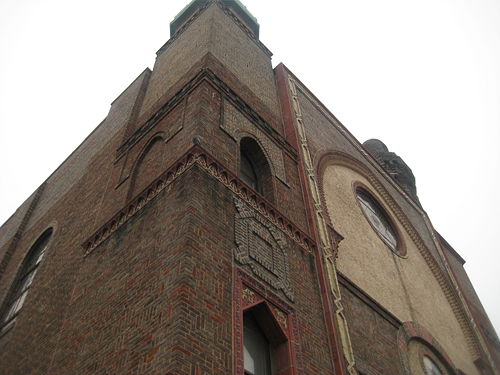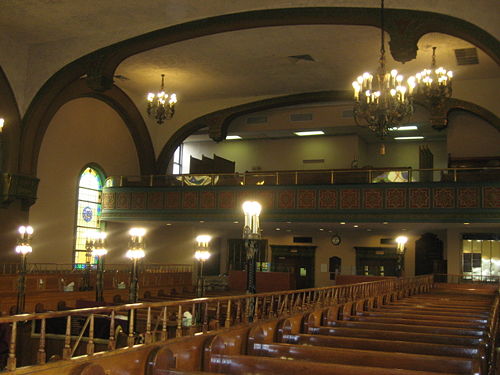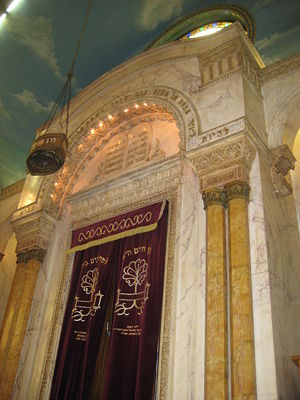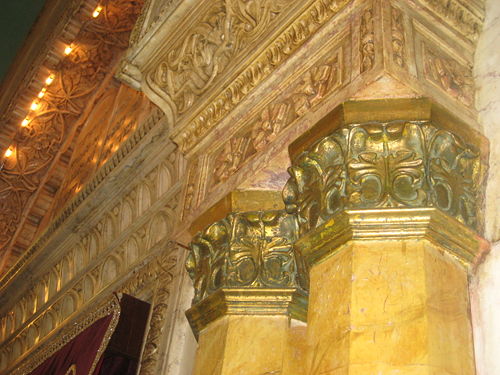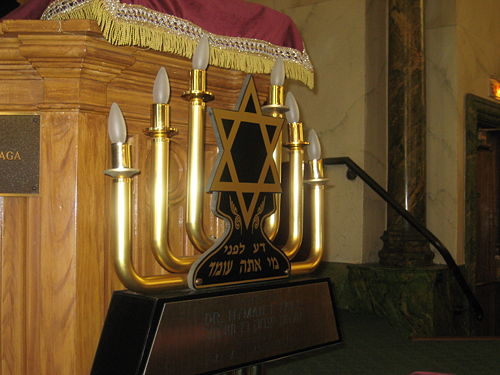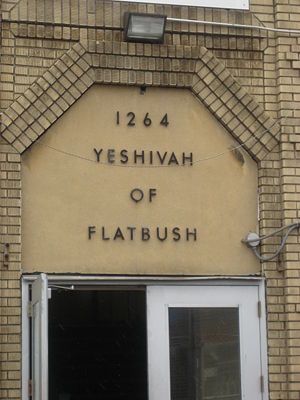Views
The Synagogue
The synagogue is the Jewish house of worship. Although its primary purpose is as a house of prayer and religious study, the synagogue is a social meeting place and a mecca for community events. It functions as social and economic welfare mechanism, distributing money and aid to those in the community who need it most. Finally, the synagogue is a means of uniting the Jewish faith with culture, and allowing it all to be enjoyed by the local Jewish community. For Midwood, Young Israel of Flatbush is one of those places of worship. With its ornate details, majestic stance, and beautiful purpose, Young Israel proudly serves one of the largest Jewish communities of Brooklyn. As a class, we got the privilege to take a trip there and behold all it has to offer. There were so many components to why Young Israel, or any other Jewish synagogue, is as purposeful as it is beautiful. Therefore, we must look at what pieces make up the synagogue’s century-old function.
Being a house of prayer, the synagogue serves as the main medium for Jewish group prayer. Necessitating a quorum of 10 men over the age of 13, prayers must be said three times daily. These prayers are in accordance to the Jewish tradition, passed down from generation to generation, starting with Abraham – the first “Jew.” In terms of prayer and religious meaning, a week’s culminating moment for the Jewish people is Shabbat, or the Sabbath. On this day, Jews in the community unite together for prayer and religious services in the synagogue. The synagogue is also used during Jewish holidays and for a variety of other community- and faith-centered events.
The synagogue has to be coordinated by a team of people to ensure everyone’s needs are met. Running the synagogue is the board of directors, made up of members of the congregation. Presiding over the religious activities of the synagogue is the rabbi. Unlike a pastor, the rabbi’s function is to answer questions for those synagogue members in an effort to preserve the holiness of one’s life in accordance to the laws of the Torah. Many synagogues also have a chazzan, or a cantor, that leads the congregation in prayer. The shamash prepares the synagogue for prayer and services while the gabbai (chosen members of the congregation itself) assist in making the services flow well. Finally, there are the kohen, or priests. They are direct descendents of Aaron (Moses’ brother) and their function is to bless the congregation during the services.
Physically, the synagogue is laid out in an auditorium-like fashion with pews running perpendicular to the front pulpit. There are two sections for people to sit in, the men’s section and the women’s section. Men and women are divided in synagogue in an effort to promote mental and sexual purity during prayer and services. In the center of the sanctuary is the prayer pedestal called the bimah. On it, the Torah read aloud to the congregation. The bimah may also be used as a platform to lead the overall service. Behind the pulpit is the most important feature of the whole synagogue – the Aron Kodesh, or the Ark. The Ark is a compartment veiled behind a curtain where the Torah scrolls are kept. This element of the synagogue is holy and when it is opened to remove the scrolls, the entirety of the congregation stands with respect to God’s gift that is the Torah. In front of and above the Ark is the Ner Tamid, or Eternal Light. This light symbolizes the commandment to keep a light burning in the Tabernacle outside of the curtain that veils the Ark (as told of in Exodus 27:20-21). Many synagogues also have a menorah, which is a seven-branched candelabrum used during Chanukkah or a nine-branched candelabrum used in the Temple.
Synagogues, like Young Israel, are much more than just a sanctuary. For example, Young Israel contains a gymnasium to hold organized community sports events, an adjoining Yeshiva school, classrooms for Jewish study, and a downstairs prayer room. It is because of these and many other factors why the synagogue is not only a house of worship but also a focal point of an entire community.
In the synagogue’s most elemental form, it is a group of individuals who have a passion to serve God and obey the laws of the Torah. It is so important to understand that without the people, the synagogue does not exist. For, in the end, it is the congregation that makes the synagogue a beacon of light that extends to the community it serves, like what Young Israel of Flatbush is to Midwood, and beyond.
The Yeshiva
Jewish children start attending Yeshiva, Jewish day school, since nursery school. Yeshiva is a special system that instills in the Jewish children a love for Judaic studies as well as a worldly knowledge in secular studies. Although expensive, this education is essential for continuing the Jewish tradition throughout the generations and all over the world. Specifically, in Midwood, there are four major Yeshivas: Yeshiva of Flatbush, a modern Orthodox elementary and high school, Magen David, a school for Sephardic Jews, Shulamith High School, an all girls elementary and high school, and Rabbi Chaim Berlin, a boys-only boarding school that focuses mainly on Judaic studies. The latter school also has a post- high school program that teaches students to go into rabbinical studies. While some yeshivas have a strict dress code, others have an actual uniform. Both include certain criteria. The female students must wear skirts that cover their knee, as well as sleeves that at least go past the elbow. In addition, the mid-drifts and neck-lines of the girls must be covered. The boys must wear dress pants, button down shirts, and formal shoes.
A regular school day usually begins at 7:30 am, with a prayer service for 45 minutes. The children then proceed to class for Judaic and Secular studies. The majority of the Judaic classes focus on Tanach, which include stories of the bible and the tellings of the prophets. The students are also taught Jewish law from ancient texts such as the Gemorrah and Mishna, as well as the Hebrew language. But, English studies are definitely not neglected. Yeshivas have intense Secular studies and AP programs that fully prepare the students for college. Due to the dual curriculum, a normal day ends at 5:30, except Fridays is early dismissal because of Shabbat.

Throughout the school year various events are held for the students, such as lectures and celebrations for holidays including Israel Independence Day and Holocaust Remembrance Day. These events further form a strong sense of community.
Jewish schooling doesn’t end when summer begins. Although many Jews from Brooklyn retreat to the Catskills in the summer, to live in their Bungalow colonies, and enjoy the countryside, some remain in Brooklyn and attend neighborhood Jewish camps. The key proponent in these camps is continued education. The camps usually consist of a separate boys and girls section. Not only do the children enjoy outdoor pools and sport fields, but they also reinforce the learning done during the year. This is made possible by the staff of Rabbis.
Before starting college, a large majority of yeshiva students take a year off to study in Israel to further their Jewish education, explore their Jewish roots, and most importantly, connect to their homeland. As a whole, Jewish education continues throughout the years of childhood and beyond.
MIKVAHS
FRIEDA KASSIN MIKVAH:
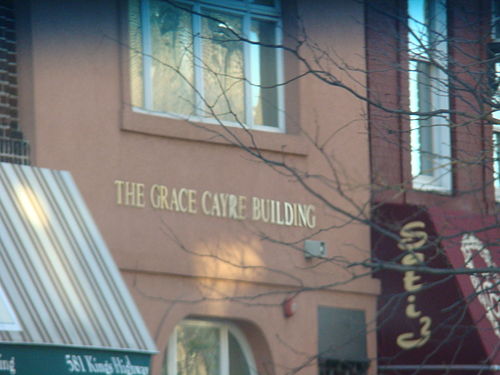
The purpose of Judaism is to make even the most mundane tasks as spiritual as possible. Many mikvahs have become extremely lavish to meet the needs of the modern Jewish woman. One example would be the Frieda Kassin Mikvah, in the Grace Carye Building, located on Kings Highway. This specific mikvah has imported Italian tiles, beauty products of all sorts to meet anyone’s needs, and elegantly designed rooms. Frieda Kassin’s hours run from 6:30 pm to 10 pm. Like all other mikvahs, one must make an appointment before arriving due to the widespread need of the mikvah.
WHAT EXACTLY IS IT?
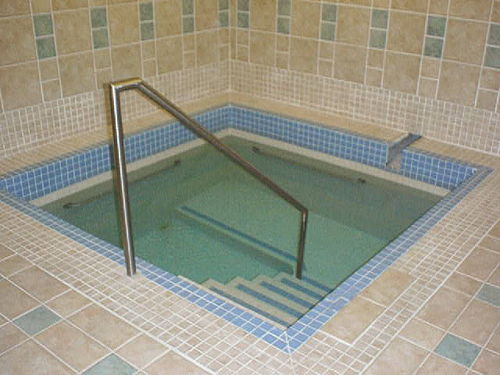
A mikvah is a ritual body of water. It is considered very holy for a woman because she uses her whole body to stay connected to G-d as she submerges into the water. The water used in the mikvah cannot be chemically filtered. Hence, many mikvahs use rainwater collected from rooftops. The mikvah must be an underground pool and/or be the vital purpose of a building.
Mikvahs should not be confused for regular baths used for personal hygiene. The Mikvah’s primary use is to sustain family purity. Mikvahs were established for the privacy of Jewish women to be able to purify themselves. Men also use mikvahs, which is before Yom Kippur or on the day of their wedding. However, women more commonly use mikvahs, especially as a spiritual cleansing method for a specific time after their menstruation. This specific time is a week after their menstruation ends. Menstruation is viewed as the loss of potential life that makes the body impure. The mikvah changes this status of the woman from impure to pure. Until the woman immerses in the mikvah, she and her husband are not to engage in any sexual activities. Immersion always takes place after nightfall and most mikvahs don’t even open until 7pm.
Mikvahs can be unfamiliar to some Jewish families but it is actually one of the most important mitzvahs in Judaism. In fact, a mikvah building is supposed to be built before the synagogue. This is because in Judaism, a community isn’t established until a mikvah is in the community. Prayer and social responsibilities of the synagogue can be held in any location. However, a mikvah is absolutely necessary for sanctifying a marriage and for maintaining a kosher lifestyle. Consequently, the mikvah is quintessential to Judaism.
THE PROCESS:
In order for a woman to become “kosher” she must first cleanse herself completely before entering the mikvah bathroom. This means from head to toe not one particle of dirt must be on her. After the cleansing, she is able to enter the bathroom. She then fully submerges herself three times in the natural water. After the first submersion, she recites a prayer for ritual purification. After the three submersions, she is given some private time to do whatever she would like.
HOW EFFECTIVE ARE THEY?
Mikvahs help sustain marriages because of the forced separation between husband and wife that enables them to keep their matrimony alive. In other words, it elevates the spirituality of the marriage. Along with this, the person is said to be reborn after the mikvah. Many married women participate in the Mikvah to purify not only their physical selves, but spiritual as well. Many women have stated that this is the pivotal moment in their life when they feel they are most connected to G-d.

